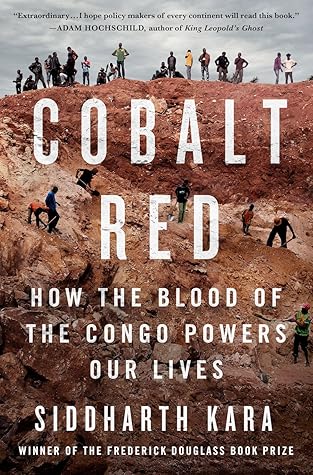More on this book
Community
Kindle Notes & Highlights
Read between
December 27 - December 30, 2023
Our daily lives are powered by a human and environmental catastrophe in the Congo.
At no point in their history have the Congolese people benefited in any meaningful way from the monetization of their country’s resources. Rather, they have often served as a slave labor force for the extraction of those resources at minimum cost and maximum suffering.
Despite being home to trillions of dollars in untapped mineral deposits, the DRC’s entire national budget in 2021 was a scant $7.2 billion, similar to the state of Idaho, which has one-fiftieth the population. The DRC ranks 175 out of 189 on the United Nations Human Development Index. More than three-fourths of the population live below the poverty line, one-third suffer from food insecurity, life expectancy is only 60.7 years, child mortality ranks eleventh worst in the world, access to clean drinking water is only 26 percent, and electrification is only 9 percent.
“I thank God for taking my babies,” she said. “Here it is better not to be born.”
A lone girl stood atop a dome of dirt, hands on her hips, eyes cast long across the barren land where giant trees once ruled. Her gold-and-indigo sarong fluttered wildly in the wind as she surveyed the ruin of people and earth. Beyond the horizon, beyond all reason and morality, people from another world awoke and checked their smartphones. None of the artisanal miners I met in Kipushi had ever even seen one.
By analyzing data, Morel uncovered one of the greatest human rights catastrophes in history. He investigated the data further and calculated that during the years 1895–1900 there was a discrepancy of 23.5 million Belgian francs in the stated value of exports of rubber and ivory from the Congo and the value stated on arrival in Antwerp.3 Someone was skimming tens of millions of francs in profit from this system of “absolute slavery,” and it could only be one person—King Leopold II.
Imagine that on a remote hill deep in the Congo’s mining provinces, a child can be found digging for cobalt, wearing a muddy shirt with the logo of the behemoth American financial services company that had to be bailed out for $180 billion during the 2008 financial crisis. Imagine what even 1 percent of that money could do in a place like this, if it were spent on the people who needed it, not stolen by those who exploited them.
Lumumba ended his incendiary speech with a declaration to the Belgian king: “Nous ne sommes plus vos singes”—“We are no longer your monkeys.”4
“Please tell the people in your country, a child in the Congo dies every day so that they can plug in their phones.”
The mothers of Kasulo endured the greatest torment of all. Most of them did not wish to speak with me. There is grief, and then there is soul-wrenching misery. There is loss, and then there is life-destroying calamity. One encounters the limits of what human hearts can endure all too often in the Congo. The land is filled with monsters, and the beast that dwells beneath Kasulo is a thousand-headed hydra, mouths agape at the surface, waiting for its prey to enter.
“Now you understand how people like us work?” “I believe so.” “Tell me.” “You work in horrible conditions and—” “No! We work in our graves.”
How can a sustainable future be built through sacrificing the very bearers of that future, through depriving children’s well-being, and worse even, through depriving children the right to be?


